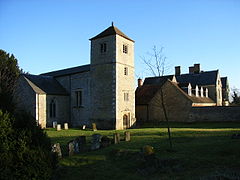Chetwode
| Chetwode | |
|---|---|
 Church and Priory of SS. Mary and Nicholas |
|
| Chetwode shown within Buckinghamshire | |
| Population | 173 (2011 Census including Barton Hartshorn) |
| OS grid reference | SP6429 |
| Civil parish |
|
| District | |
| Shire county | |
| Region | |
| Country | England |
| Sovereign state | United Kingdom |
| Post town | Buckingham |
| Postcode district | MK18 |
| Dialling code | 01280 |
| Police | Thames Valley |
| Fire | Buckinghamshire |
| Ambulance | South Central |
| EU Parliament | South East England |
| UK Parliament | |
Chetwode is a village and civil parish about 4 miles (6.4 km) southwest of Buckingham in the Aylesbury Vale district of Buckinghamshire. The parish is bounded to the southwest and southeast by a brook called The Birne, which here also forms part of the county boundary with Oxfordshire.
In ancient times the area was known simply as Cet, the Brythonic word for "woodland". Following the settlement of Anglo Saxon tribes in the area, the suffix "wood" was added to the name to form a compound word of British and Old English origins: a common occurrence in this part of the country (for example, Brill). In AD 949 the area was known as Cetwuda.
There is a manor at Chetwode that stayed in the same family from the time of the Domesday Book in 1086 through to the 1960s. The Domesday Book records that in 1086 Robert de Thain held the manor from Odo, Bishop of Bayeux.
In 1244 Sir Ralphe de Norwich founded an Augustinian priory at Chetwode. In 1460, owing to its poverty, the priory was dissolved and annexed to the nearby Nutley Abbey in Long Crendon. This led to the first recognition of Chetwode as a village rather than just a priory.
The Church of England parish church of Saint Mary and Saint Nicholas and was once part of the Augustinian priory church. However the parish church had become ruinous in the 15th century and this building replaced it as the parish church in 1480. The stonework is a fine example of the work of the 13th century, particularly the sedilia, the east window of five lancets and the triple-lancet window on the south side, with stained glass of the 13th and 14th centuries. The 14th century north chapel later became the manor pew.
...
Wikipedia

